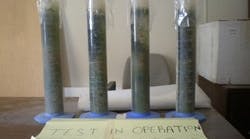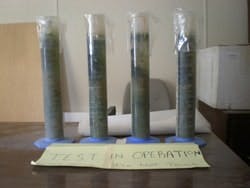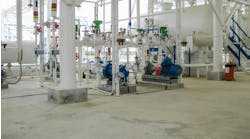This Month’s Puzzler
We add a polymer agent as a coagulant to a cosmetic tank. During development, the ingredient was added by hand. In a large bulk tank, this is too inconvenient. So, we enlisted an open-impeller centrifugal pump to batch the agent to the bulk mixing tank, i.e., reactor. Now, however, the product, which should have a consistency of tapioca pudding, resembles runny soup. How should we investigate this problem and what could be the cause? How do you suggest we can improve the consistency?
USE AN EDUCTOR
It seems that process development work has been done well but things are not working as planned on the commercial scale. The problem as stated does not tell how and where the coagulant is being added and if it is a liquid or a solid. If it is a liquid, it could be added using an eductor on the inlet side of the pump. This should disperse the liquid coagulant as it goes through the pump. If the coagulant is a solid, it can be added using similar devices that are commercially available. They generate sufficient vacuum to suck a liquid or solid. In both cases, the addition should be close to the cavity of the pumping device.
Girish Malhotra, president
EPCOT International, Pepper Pike, Ohio
CHANGE THE PUMP
When you use a centrifugal pump to move the agent, you are essentially adding a step to the batch process. The pump impeller whips the polymer, much like eggs in a blender. You still get eggs but they are different. The centrifugal pump is very likely adding heat and, quite possibly, air to the agent. If the polymer agent is tolerant and it suits the process flow, you could use a diaphragm pump. A peristaltic pump is even gentler on the pumped fluid. Both pumps I mentioned are very accommodating to adjustment of flow rate and pressure.
Tyrone Riley, maintenance supervisor
The Shepherd Chemical Co., Norwood, Ohio
CHECK SHEARING
The pump may be shearing the thickening agent and reducing its effectiveness. This could be tested in the lab using a blender to shear the material before adding it. Mixing intensity can often be a problem with thickeners.
Bennett Willis, assistant professor
Brazosport College, Lake Jackson, Texas
RUN LABORATORY TESTS
You are either imparting too much shear, tearing apart the coagulant, or not enough shear, allowing two phases to separate (although you do not mention any lumps). In a situation like this, I always go to the lab, testing small additions/unit time, with an adjustable-rate mixing device — getting an idea of “wetting” capabilities. Most times, I insist on master batches, in so far as possible, to be fed into the production batch tank/piping (venturi flow), creating a smoother mixing and more uniform product. Miscibility is the key.
Tom Murphy, CEO
Puritrol, Inc., Centerville, Mass.
USE A DIFFERENT PUMP
There is a good chance that the polymer agent is being broken down by shear from the centrifugal pump. This could be investigated in the lab by making two batches of the product. One would be blended using virgin polymer agent, the other would use a polymer additive that has been stressed using a high shear agitator. If this is indeed the case, replacing the centrifugal pump with a positive displacement pump, such as a progressive cavity or hose pump, should solve your problem.
Tom Patten, process engineer
O’Neal Inc., North Charleston, S.C.
WATCH THE SHEAR
It is probable the polymer you are using is a long chain hydrocarbon. These molecules fragment and lose their effectiveness when exposed to even the slightest of shear forces. Centrifugal pumps are exactly what you do not want to use when moving polymers like this — you need a low shear pump, e.g., a positive displacement pump. Find another way to do your mixing with low shear conditions. I bet if you contact your polymer vendor it can give you recommendations on how to do this; if not, there are other more qualified vendors out there. Talk to one of them.
Glen Oswald, engineer advisor
Mosaic Phosphates, Plymouth, Minn.
SWITCH THE PUMP
The centrifugal pump is putting too much shear in the additive and causing a viscosity change. Try using a metering pump of some kind with low shear capability.
Ron Strybos, salt cavern storage specialist
Air Liquide Large Industries U.S. LP, Houston
LOOK AT OTHER INDUSTRIES
If you are adding a coagulant through a pump, you are both under-mixing and
over-mixing. Under-mixing in that mixing with a pump is very inefficient, perhaps only 10%, especially in a large tank. Over-mixing produces intense mixing in the pump, tearing the coagulated particles apart again — hence the soup. It is best to gently mix with an impeller, something like the milk industry uses for cottage cheese, etc. You should talk to the coagulant supplier.
Cliff Gaddis, senior project engineer
NOV-Brandt, Conroe, Texas
REDESIGN THE SYSTEM
You are shearing the polymer with the centrifugal pump. Invest in a polymer make-down system.
Jon Robson, general manager
Wellons Water Technology, Vancouver, Wash.
TAKE A SAMPLE
Consider the possibility that the shear from the pump is reducing the molecular weight of polymeric coagulating agent. Reducing the molecular weight could very well reduce the viscosity of the solution. Testing a sample of the solution from before the centrifugal pump for susceptibility to shear thinning could point to the source of the lowered viscosity. If the centrifugal pump is the source of the problem, a lower shear pump could be the answer.
Rob Vermeulen, technologist
Applied Materials, Santa Clara, Calif.
SCALE-UP POSES ISSUES
Too much shear due to the use of a centrifugal pump is breaking down the polymer. Use a diaphragm pump for the polymer addition.
Many times when going from pilot plant to fullscale production, things that are least expected will jump up and bite you. While working for a major food manufacturer, one of these little guys bit me and my team.
The fullscale plant operation was designed to add all ingredients using load cells and pneumatic conveying. After the first batch, the product was not acting or tasting right. Several minor ingredients were trapped in the conveying system! They were hand fed after that and no more batches were ruined.
Donald Phillips, engineer
Phillips Engineering, Melbourne, Fla.
GO WITH PREMIX
Probably the addition pump is breaking down the polymer structure preventing a rise in viscosity. Try adding the premixed polymer solution or change the centrifugal pump for a pneumatic pump.
Emilio Malaguti, technical director
Chemtron, Davie, Fla.
SWITCH THE PUMP
Depending on the chain length of the polymer being used, the centrifugal pump may have sheered the polymer. I recommend switching to a diaphragm pump to dose the polymer into the mixing tank.
Scott Patrick, process engineer
DuBois Chemicals, Inc., Cincinnati, Ohio
In the experiment above, polymer was added to
clay to floculate it. Further tests were done to find
out whether shearing the clay and polymer mixture
would change the settling time of the clay.
Source: Alison Springer-Wilson, Mosaic Phosphates
VERIFY IN THE LAB
My guess would be that the centrifugal pump is shearing the polymer before it gets to the stuff being treated in the cosmetic tank, limiting the polymer’s effectiveness. To test this, you could obtain samples of polymer and material being coagulated and shear the polymer at different levels before you add it to the cosmetic tank, to see if you get a consistency similar to the runny soup or tapioca pudding. If shear is what causes the change in consistency, I would improve consistency by installing a positive displacement pump with low shear instead of the centrifugal pump.
Alison Springer-Wilson, co-op student
Mosaic Phosphates, Plymouth, Minn.
SWAP THE PUMP
Add the polymer agent with a positive displacement metering pump.
Wally Marshall, contract analyzer specialist
Dow Chemical Co., Freeport, Texas
OPT FOR A LOW SHEAR PUMP
Change the pump. You are busting up the medium with high shear being introduced into it. My take is the coagulant may be susceptible to shear. Try a low shear pump. Would a diaphragm pump, tube pump or lobe pump work?
Michael Waugh, consultant
Lutz, Fla.
SLOW IT DOWN
It seems that the shear forces created by the impeller negatively affect the polymer agent, breaking down the actual polymer-to-polymer molecular forces. Consequently, this prevents the thickening (coagulation) of the product; the swellability index of the polymer coagulant has decreased markedly. One solution would be to obtain a slower impeller pump with lower shear forces being imposed on the actual polymer agent coagulant. (Assuming these changes can be supported will probably mean a larger motor and other process changes.)
Deepesh Ghela, technical development director
Hardeep Chemical Co., Kwazulu, Natal, South Africa
IT’S THE IMPELLER
We are not even sure that the pump is shredding the polymer but it is a good starting point. In engineering, money is everything. With pumps it often costs almost as much to change the impeller as to change the whole pump. A closed impeller may be the cheapest answer provided that the change in the pump curve is acceptable. Being a new project, the vendor may be willing to accept the change with a minor cost. This may be the solution if you can experiment with a batch to see if the closed impeller works well. If you must bid a replacement pump, it is best to suggest an open bid not a sole source. This may provide the leverage you need with the pump vendor. He wants to keep his customers to himself, not share them.
Another issue is agitation in the tank itself. You may want to look at ways to minimize mixing time while balancing shear. Shear is a direct function of agitator speed, so reducing the shaft speed may help — if you can live with the negative effect on mixing time. Changing the batch recipe may help.
Knowing how the polymer works is important. The shaft could be run at reduced speed while the polymer is blending but at high speeds before that. All the minor ingredients should be mixed early while delaying the polymer addition for as long as possible because mixing efficiency and time will increase once the polymer is added. Unfortunately, laboratory testing won’t do you much good. With many processes, it’s best to take to a scale close to your production size and fix the problems there.
Dirk Willard, process engineer
CITGO Petroleum Corporation, Lemont, Ill.
February’s Puzzler
A contractor installing a new motor starter for a crude pump in a motor control center (MCC) received permission to trip the breaker controlling the old bucket. With the trip, we lost the crude pump, the gas oil pump and several recirculation pumps in an atmospheric crude distillation unit. This breaker was supposed to go only to the pump being replaced. The operator responded quickly, bringing the unit back up although there were severe swings in column temperature and pressure. An investigation later found no loop sheets or inspection records. The wiring diagram for the MCC didn’t show any common wiring for the starters, but then no as-built drawing was produced and no commissioning documentation exists. What can be done to avoid this problem in the future and address what may be a refinery-wide problem?
Send us your comments, suggestions or solutions for this question by January 9, 2009. We’ll include as many of them as possible in the February 2009 issue and all on CP.com. Send visuals — a sketch is fine. E-mail us at [email protected] or mail to Process Puzzler, Chemical Processing, 555 W. Pierce Road, Suite 301, Itasca, IL 60143. Fax: (630) 467-1120. Please include your name, title, location and company affiliation in the response.
And, of course, if you have a process problem you’d like to pose to our readers, send it along and we’ll be pleased to consider it for publication.



